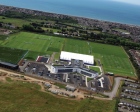CP takes control of lighting at Seagulls’ new training ground

Fully addressable and networkable lighting control for Brighton & Hove Albion’s (The Seagulls) new training and teaching facility is provided by systems from CP Electronics. The state-of-the-art American Express Elite Football Performance Centre in Lancing, West Sussex, include CP’s Rapid and Vitesse systems. They were chosen for the flexibility and ease of configuration to any floor layout.
The site includes 11 full- and half-size pitches.
The distinctive Y-shaped building has an indoor pitch and secure accommodation area for the club’s professional squad and academy youth team. A separate wing is used for common recreation, medical treatment, gym, offices, teaching and a media centre.
Supplied by Newey & Eyre’s Crawley branch and installed by NG Bailey, the Rapid system has been used in all areas and configured to provide easy control of scene setting in training and meeting rooms.
The Vitesse lighting-distribution system has been installed in offices, toilets and corridors for presence detection and in offices with natural lighting to provide daylight dimming. The Vitesse system also assists with the testing of emergency lighting and provides a high level of lighting control without the need for a control network function.







